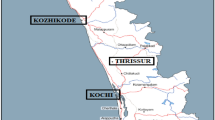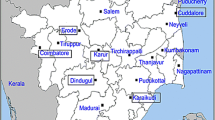Abstract
For a widely varied wind climate in India, a single type of Extreme Value Distribution (EVD) is not suitable to fit wind speed data for all geographical locations and climatic conditions. This may lead to the inappropriate estimation of the design wind speed (Vd). In this study, a new approach, combining the merits of both the block maxima and the peaks over threshold approaches, has been used to determine the Vd. The hourly mean wind speed data of three stations, viz., Trivandrum, Bombay and Calcutta have been classified into block of months of the years 1973−2005, 1969−2007, and 1969−1994 respectively. The extreme peaks over the appropriate threshold value have been fitted into the generalized EVD (type-I, II and II). The results indicate that Fréchet distribution is the most suitable distribution for all three stations. March has the highest Vd for Trivandrum, whereas, for both Bombay and Calcutta it is September. Bombay shows highest overestimation of the Vd as given in Indian code of standard, whereas, for Trivandrum, and Calcutta these deviations have been found to be comparatively less. The five plotting position formulae have also been compared based on two goodness of fit tests, viz., R2, and RMSE.
Similar content being viewed by others
References
An, Y. and Pandey, M. D. (2005). “A comparison of methods of extreme wind speed estimation.” Journal of Wind Engineering and Industrial Aerodynamics, Vol. 93, No. 7, pp. 535–545, DOI: 10.1016/j.jweia.2005.05.003.
Castillo, E., Hadi, A. S., Balakrishnan, N., and Sarabia, J. M. (2005). Extreme value and related models with applications in engineering and science, New Jersey: Wiley-Interscience, John Wiley & Sons, Inc.
Celik, Ali Naci (2003). “A statistical analysis of wind power density based on the Weibull and Rayleigh models at the southern region of Trrkey.” Renewable Energy, Vol. 29, No. 4, pp. 593–604, DOI: 10.1016/j.renene.2003.07.002.
Chang, T. J., Wu, Y. T., Hsu, H. Y., Chu, C. R., and Liao, C. M. (2003). “Assessment of wind characteristics and wind turbine characteristics in Taiwan.” Renewable Energy, Vol. 28, No. 6, pp. 851–871, DOI: 10.1016/S0960-1481(02)00184-2.
Chang, T. P. (2011). “Performance comparison of six numerical methods in estimating Weibull parameters for wind energy application.” Applied Energy, Vol. 88, No. 1, pp. 272–282, DOI: 10.1016/j.apenergy.2010.06.018.
Coles, S. (2001). An introduction to statistical modeling of extreme values. London: Springer.
Cook, N. and Harris, R. I. (2004). “Exact and general FT1 penultimate distributions of extreme wind speeds drawn from tail-equivalent Weibull parents.” Structural Safety, Vol. 26, No. 4, pp. 391–420, DOI: 10.1016/j.strusafe.2004.01.002.
Cook, N. J. (1982). “Towards better estimation of extreme winds.” Journal of Wind Engineering and Industrial Aerodynamics, Vol. 9, No. 3, pp. 295–323, DOI: 10.1016/0167-6105(82)90021-6.
Cook, N. J. (1985). The designer’s guide to wind loading of building structures. Part 1: background, damage survey, wind data and structural classification, London: Butterworths.
Cook, N. J., Harris, R. I., and Whiting, R. (2003). “Extreme wind speeds in mixed climates revisited.” Journal of Wind Engineering and Industrial Aerodynamics, Vol. 91, No. 3, pp. 403–422, DOI: 10.1016/S0167-6105(02)00397-5.
Cunnane, C. (1978). “Unbiased plotting positions: A review.” Journal of Hydrology, Vol. 37, Nos. 3–4, pp. 205–222, DOI: 10.1016/0022-1694(78)90017-3
Ferreira, A. and Haan L. d. (2015). “On the block maxima method in extreme value theory: PWM estimators.” Annals of Statistics, Vol. 43, No. 1, pp. 276–298, DOI: 10.1214/14-AOS1280.
Fisher, R. A. and Tippet, L. H. C. (1928). “Limiting forms of the frequency distribution of the largest or smallest members of a sample.” Proceeding of the Cambridge Philosophical Society, Vol. 24, No. 2, pp. 180–190, DOI: 10.1017/S0305004100015681.
Galambos, J. and Macri, N. J. (1995). “Classical extreme value model and prediction of extreme winds.” Journal of Structural Engineering, Vol. 125, No. 7, pp. 792–794, DOI: 10.1061/(ASCE)0733-9445 (1999)125:7(792).
Goel, N. k. and De, M. (1993). “Development of unbiased plotting position formula for general extreme value distribution.” Stochastic Environmental Research and Risk Assessment, Vol. 7, No. 1, pp. 1–13, DOI: 10.1007/BF01581563.
Gringorten, II. (1963). “A plotting rule for extreme probability paper.” Journal of Geophysical Research, Vol. 68, No. 3, pp. 813–814, DOI: 10.1029/JZ068i003p00813.s
Gumbel, E. J. (1958). Statistics of extremes, London: Columbia University Press, New York.
Guo, S. L. (1990). “A discussion on unbiased plotting positions for the general extreme value distribution.” Journal of Hydrology, Vol. 121, Nos. 1–4, pp. 33–44, DOI: 10.1016/0022-1694(90)90223-K.
Harris, I. (2005). “Generalised Pareto methods for wind extremes. Useful tool or mathematical mirage?” Journal of Wind Engineering and Industrial Aerodynamics, Vol. 93, No. 5, pp. 341–360, DOI: 10.1016/j.jweia.2005.02.004.
Harris, R. I. (1996). “Gumbel revisited: A new look at extreme value statistics applied to wind speeds.” Journal of Wind Engineering and Industrial Aerodynamics, Vol. 59, No. 1, pp. 1–22, DOI: 10.1016/0167-6105(95)00029-1.
Harris, R. I. (2009). “XIMIS, a penultimate extreme value method suitable for all types of wind climate.” Journal of Wind Engineering and Industrial Aerodynamics, Vol. 97, Nos. 5–6, pp. 271–286, DOI: 10.1016/j.jweia.2009.06.011.
Harris, R. I., and Cook, N. J. (2014). “The parent wind speed distribution: Why Weibull?” Journal of Wind Engineering and Industrial Aerodynamics, Vol. 131, pp. 72–87, DOI: 10.1016/j.jweia.2014.05.005.
Hazen, A. (1914). “Storage to be provided in impounding reservoirs for municipal water supply.” Transactions of the American Society of Civil Engineers, Vol. 1308, No. 77, pp. 1547–1550.
In-na, N. and Nguyen, V.-T.-V. (1989). “An unbiased plotting position formula for the generalized extreme value distribution.” Journal of Hydrology, Vol. 106, pp. 193–209, DOI: 10.1016/0022-1694(89) 90072–3.
The Bureau of Indian Standards (2015). Design loads (other than earthquake) for buildings and structures — Code of practice, Indian Standards 875 (Part 3) (Third Revision), New Delhi, India.
Kasperski, M. (2000). Specification and codification of design wind loads, Germany: Habilitation Thesis, Ruhr-Universität Bochum.
Kasperski, M. (2009). “Specification of the design wind load—A critical review of code concepts.” Journal of Wind Engineering and Industrial Aerodynamics, Vol. 97, No. 7, pp. 335–357, DOI: 10.1016/j.jweia.2009.05.002.
Kaspersky, M. (2010). “Estimation of design wind speed.” 7th International Advance School on Wind Engineering, Chennai, pp. 449–478.
Kim, S., Shin, H., Joo, K., and Heo, J.-H. (2012). “Development of plotting position for the general extreme value distribution.” Journal of Hydrology, Vol. 475, pp. 259–269, DOI: 10.1016/j.jhydrol.2012.09.055.
Lagomarsino, S., Piccardo, G., and Solari, G. (1992). “Statistical analysis of high return period wind speed.” Journal of Wind Engineering and Industrial Aerodynamics, Vol. 41, No. 1–3, pp. 485–496, DOI: 10.1016/0167-6105(92)90452–G.
Lakshmanan, N., Gomathinayagam, S., Harikrishna, P., Abraham, A., and Ganapathi, S. C. (2009). “Basic wind speed map of India with long-term hourly wind data.” Current Science, Vol. 96, No. 7, pp. 911–922.
Li, J., Li, C., He, L., and Shen, J. (2015). “Extending modulating functions for simulation of wind velocities with weak and strong nonstationarity.” Renewable Energy, Vol. 83, pp. 384–397, DOI: 10.1016/j.renene.2015.04.044.
Lombardo, F. T. (2012). “Improved extreme wind speed estimation for wind engineering applications.” Journal of Wind Engineering and Industrial Aerodynamics, Vols. 104–106, pp. 278–284, DOI: 10.1016/j.jweia.2012.02.025.
Makkonen, L. (2008). “Problems in the extreme value analysis.” Structural Safety, Vol. 30, No. 5, pp. 405–419, DOI: 10.1016/j.strusafe.2006.12.001.
Peterka, J. A. and Shahid S. (1998). “Design gust wind speeds in the United States.” Journal of Structural Engineering, Vol. 124, No. 2, pp. 207–214, DOI: 10.1061/(ASCE)0733-9445(1998)124:2(207).
Safari, B., and Gasore, J. (2010). “A statistical investigation of wind characteristics and wind energy potential based on the Weibull and Rayleigh models in Rwanda.” Renewable Energy, Vol. 35, No. 12, pp.2874–2880, DOI: 10.1016/j.renene.2010.04.032.
Sarkar, A., Gugliani, G. K., and Deep, S. (2017). “Weibull model for wind speed data analysis of different locations in India.” KSCE Journal of Civil Engineering, pp. 1–13, DOI: 10.1007/s12205-017-0538-5
Sarkar, A., Kumar, N., and Mitra, D. (2014). “Extreme wind climate modeling of some locations in India for the specification of the design wind speed of structures.” KSCE Journal of Civil Engineering, pp. 1496–1504, DOI: 10.1007/s12205-014-0428-z.
Simiu, E. (1994). Estimation of extreme wind speeds, state of the art in wind engineering, London: Wiley Eastern Limited, New Delhi.
Simiu, E. and Heckert, N. A. (1996). “Extreme wind distribution tails: A ‘Peaks over Threshold’ Approach.” Journal of Structural Engineering, Vol. 122, No. 5, pp. 539–547, DOI: 10.1061/(ASCE)0733-9445 (1996)122:5(539).
Soukissian, T. H. and Christos, T. (2015). “The effect of the generalized extreme value distribution parameter estimation methods in extreme wind speed prediction.” Natural Hazards, Vol. 78, pp. 1777–1809, DOI: 10.1007/s11069-015-1800-0.
Tukey, J. W. (1977). Exploratory data analysis. Addison-Wesley, Reading, MA.
Vega, R. (2008). Wind directionality: A reliability based approach, PhD Thesis, Texas Tech University, Lubbock, TX, USA.
Weisser, D. (2003). “A wind energy analysis of Grenada: An estimation using the ‘Weibull’ density function.” Renewable Energy, Vol. 28, pp. 1803–1812, DOI: 10.1016/S0960-1481(03)00016-8.
Author information
Authors and Affiliations
Corresponding author
Rights and permissions
About this article
Cite this article
Gugliani, G.K., Sarkar, A., Bhadani, S. et al. A Novel Approach for Accurate Assessment of Design Wind Speed for Variable Wind Climate. KSCE J Civ Eng 23, 608–623 (2019). https://doi.org/10.1007/s12205-018-1431-6
Received:
Revised:
Accepted:
Published:
Issue Date:
DOI: https://doi.org/10.1007/s12205-018-1431-6




